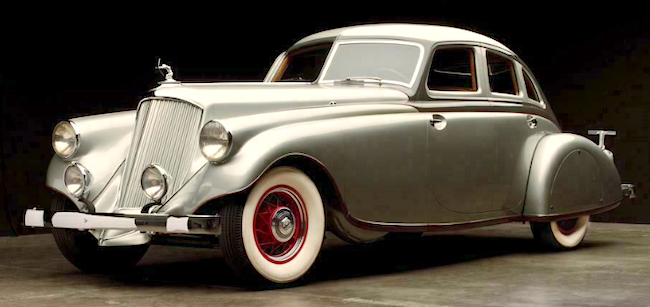In the 1940s and well into the 1950s General Motors used three body platforms for the various models of its five automobile brands. These bodies were designated A, B and C, where A-bodies tended to be used for Chevrolets and Pontiacs and
C-bodies for Cadillacs and upscale Buicks.
B-bodies were generally found on Oldsmobiles and lower-priced Buick models.
There were many exceptions, one of which is the subject of the present post.
As further background, usual American car industry practice in those days was to retain a redesigned body for three or even more model years before replacing it with a new design. Therefore, it was highly unusual for a brand, or even a model, to be based on a body for one year only. The most extreme example of this is that of 1958 Chevrolets and Pontiacs.
Today's example is not that of a redesigned body being used for only a single model year. Instead, it's a case of a model using a slightly inappropriate body for a single year while its replacement was still under development.
That model is the Buick Special (or Model 40), the brand's lowest-price line. During the 1940s, Buick Specials used GM's B-body while the more expensive Buick Super and Roadmaster models were C-body based. The C-body was redesigned for the 1948 model year and used by Oldsmobile's line-topper 98 series and Cadillacs. Buick Supers and Roadmasters used that body for an extended (for Buick) 1949 model year. Then C-bodies were redesigned for 1950. But a redesigned B platform was not due for production until the 1951 model year, and the current B-body was stylistically obsolete, having first appeared for 1941.
So what could Buick do for its Special line? The decision was to give Specials the up-market C-body for 1950. The marketing danger was that Specials, sharing the same platform as Supers, next up in Buick's hierarchy, might steal sales from the more profitable Supers. And that is just what happened. For 1950, about 338,000 Specials were made compared to 252,000 Supers, whereas for 1951 when Specials reverted to B-bodies, the respective numbers were 165,000 and 169,000 (overall production slowed that year due to the Korean War).
Gallery
1949 Buick Special - for sale photo
Few 1949 Specials were built. They looked essentially the same as comparable 1947 and 1948 models. This basic B-body design first appeared for the 1941 model year.
1949 Buick Super Sedanet - Hyman Ltd. photo
A fastback 1949 Buick Super, built on the C-platform.
1950 Buick Special - Worldwide Auctions photo
Here is the short-wheelbase C-body Buick Special. Roadmasters and some Supers were longer and had six-window passenger compartments.
1950 Buick Super Tourback Sedan - brochure illustration
This is a short-wheelbase Super. Its exterior is almost identical to that of the lower-priced Special with the same body.
1951 Buick Special Deluxe - Mecum auction photos
Now for views of a 1951 Buick Special with its redesigned B-body.
Its fenderline is higher and has less sculpting that the previous year's C-body version. The passenger compartment greenhouse differs in the C-pillar area.
Rear-quarter view. GM's new B-bodies were intentionally less-impressive than the up-market C-bodies.
1951 Buick Super Riviera Sedan - Mecum
A long-wheelbase C-body Buick Super with its six-window greenhouse.




















































